View in other NatureServe Network Field Guides
NatureServe
Montana
Utah
Wyoming
Idaho
Wisconsin
British Columbia
South Carolina
Yukon
California
New York
Raceme Milkvetch - Astragalus racemosus
State Rank Reason (see State Rank above)
Raceme milkvetch occurs near the margin of its range in Montana, where several, mostly small populations have been found in Carter and Fallon counties. Its response to grazing is unknown, however it accumulates selenium and may be toxic to livestock. Accurate population and trend data are lacking.
General Description
Raceme Milkvetch is a coarse, herbaceous perennial with few to many erect stems, 15-70 cm high, and arising from a woody taproot and branched rootcrown. The pinnately compound leaves are 4-15 cm long with 11-31 narrowly to broadly elliptic leaflets. Foliage is thinly to densely covered with short hairs. Inflorescences with 15-70 densely clustered flowers arise from the axils of the upper leaves. The nodding, whitish flowers are 16-21 mm long with a partially reflexed upper petal and purplish tinged lower petals. The calyx is 8-11 mm long and glabrous or with scattered hairs. The pendant, oblong-elliptic pods have a basal, 3-7 mm long stalk, are glabrous, triangular in cross-section, with 3 sides that are nearly flat and equal-width, and 15-30 mm long.
Our plants are variety racemosus.
Phenology
Flowering occurs in late June-early July; fruits persisting.
Diagnostic Characteristics
The combination of coarse, erect stems, short pubescence, and pendant pods, triangular in cross-section, is diagnostic of this species in the n. Great Plains. The more common Astragalus drummondii is similar but has pods dorsiventrally compressed with 2 parallel grooves on the bottom, and has foliage with long spreading hairs.
Species Range
Montana Range
Range Descriptions
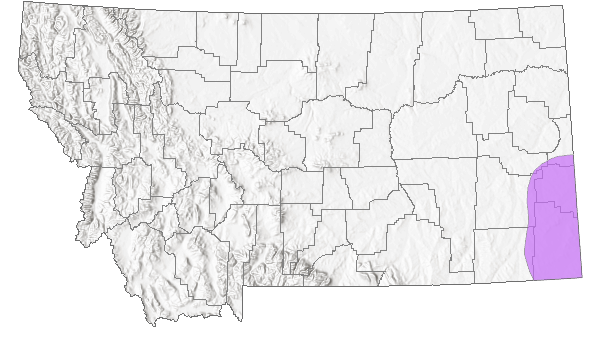
 Native
Native
Range Comments
MT, ND south to UT, NM, TX and OK (Lesica et al. 2012. Manual of Montana Vascular Plants. BRIT Press. Fort Worth, TX).
Observations in Montana Natural Heritage Program Database
Number of Observations: 23
(Click on the following maps and charts to see full sized version)
Map Help and Descriptions
Relative Density
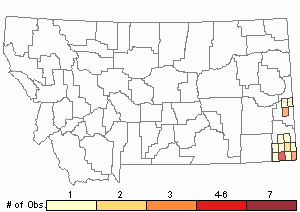
Recency
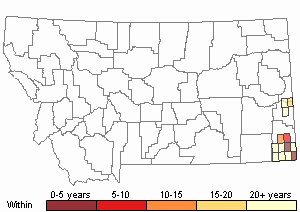
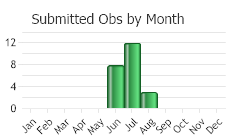
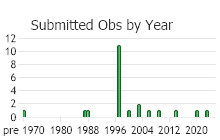
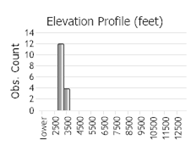 (Observations spanning multiple months or years are excluded from time charts)
(Observations spanning multiple months or years are excluded from time charts)
Habitat
Raceme milkvetch typically grows in grasslands on heavy soil derived from shale. It is an indicator of - and confined to - selenium soils (Great Plains Flora Assoc. 1986), typically occurring on "gumbo" in "low sites with an abundance of alkali" (Barr 1983). Soils with a high selenium content are found locally in Montana on substrates derived from marine shales (Vanderhorst et al. 1998). Vegetation at these sites varies from grasslands to sagebrush steppe and greasewood communities.
The largest and most robust population in Montana occurs on the gentle slopes of a low relief shale ridge. This site supports a high quality Elymus lanceolatus/Stipa viridula grassland with eroded areas dominated by Eriogonum pauciflorum, and has among the highest diversity of forbs observed in Carter County (Vanderhorst et al. 1998). Another large population was documented in Stipa comata/Carex filifolia grassland at the contact zone between shale and sandstone, with Stipa comata/Carex filifolia dominant on the sandstone and wheatgrasses (Elymus lanceolatus and/or Pascopyrum smithii) on the shale.
In the breaklands of southeastern Carter County, it occurs sparsely among sandstone and shale outcrops dominated by a mix of sagebrush steppe and Stipa comata/Carex filifolia grasslands. It has also been occasionally documented in shrub dominated communities, including Artemisia tridentata ssp. wyomingensis/Elymus lanceolatus and Sarcobatus vermiculatus/Elymus lanceolatus. Another selenium indicator, Stanleya pinnata (prince's plume), grows in the same habitat at two sites in Carter County (Vanderhorst et al. 1998).
Ecological Systems Associated with this Species
Ecology
POLLINATORS The following animal species have been reported as pollinators of this plant species or its genus where their geographic ranges overlap:
Bombus vagans,
Bombus appositus,
Bombus auricomus,
Bombus bifarius,
Bombus borealis,
Bombus centralis,
Bombus fervidus,
Bombus flavifrons,
Bombus huntii,
Bombus mixtus,
Bombus nevadensis,
Bombus rufocinctus,
Bombus ternarius,
Bombus terricola,
Bombus occidentalis,
Bombus pensylvanicus,
Bombus griseocollis, and
Bombus insularis (Macior 1974, Thorp et al. 1983, Mayer et al. 2000, Colla and Dumesh 2010, Wilson et al. 2010, Koch et al. 2012, Miller-Struttmann and Galen 2014, Williams et al. 2014).
Management
Raceme milkvetch accumulates selenium and may cause poisoning of livestock. However, it is apparently rarely eaten by livestock (Great Plains Flora Association, 1988). No browsed plants have been observed during surveys in Montana, as populations documented were in rangelands without evidence of recent livestock use (Vanderhorst et al. 1998). The site of the largest population has an unusually high forb diversity and cover of Nasella viridula (green needlegrass) indicating excellent condition for that range site. It is possible that livestock are excluded from areas known to have selenium soils or that grazing in those areas is timed seasonally to avoid poisonous plants (Vanderhorst et al. 1998). The range literature does not indicate whether raceme milkvetch is an increaser or decreaser under grazing. The fact that its largest known numbers occur in areas of high quality range suggests that it warrants some attention from range managers and livestock operators.
Threats or Limiting Factors
STATE THREAT SCORE REASON
Threat impact not assigned because threats are not known (MTNHP Threat Assessment 2021).
References
- Literature Cited AboveLegend:
 View Online Publication
View Online Publication Colla, S.R. and S. Dumesh. 2010. The bumble bees of southern Ontario: notes on natural history and distribution. Journal of the Entomological Society of Ontario 141:39-68.
Colla, S.R. and S. Dumesh. 2010. The bumble bees of southern Ontario: notes on natural history and distribution. Journal of the Entomological Society of Ontario 141:39-68. Koch, J., J. Strange, and P. Williams. 2012. Bumble bees of the western United States. Washington, DC: USDA Forest Service, Pollinator Partnership. 143 p.
Koch, J., J. Strange, and P. Williams. 2012. Bumble bees of the western United States. Washington, DC: USDA Forest Service, Pollinator Partnership. 143 p. Lesica, P., M.T. Lavin, and P.F. Stickney. 2012. Manual of Montana Vascular Plants. Fort Worth, TX: BRIT Press. viii + 771 p.
Lesica, P., M.T. Lavin, and P.F. Stickney. 2012. Manual of Montana Vascular Plants. Fort Worth, TX: BRIT Press. viii + 771 p. Macior, L.M. 1974. Pollination ecology of the Front Range of the Colorado Rocky Mountains. Melanderia 15: 1-59.
Macior, L.M. 1974. Pollination ecology of the Front Range of the Colorado Rocky Mountains. Melanderia 15: 1-59. Mayer, D.F., E.R. Miliczky, B.F. Finnigan, and C.A. Johnson. 2000. The bee fauna (Hymenoptera: Apoidea) of southeastern Washington. Journal of the Entomological Society of British Columbia 97: 25-31.
Mayer, D.F., E.R. Miliczky, B.F. Finnigan, and C.A. Johnson. 2000. The bee fauna (Hymenoptera: Apoidea) of southeastern Washington. Journal of the Entomological Society of British Columbia 97: 25-31. Miller-Struttmann, N.E. and C. Galen. 2014. High-altitude multi-taskers: bumble bee food plant use broadens along an altitudinal productivity gradient. Oecologia 176:1033-1045.
Miller-Struttmann, N.E. and C. Galen. 2014. High-altitude multi-taskers: bumble bee food plant use broadens along an altitudinal productivity gradient. Oecologia 176:1033-1045. Thorp, R.W., D.S. Horning, and L.L. Dunning. 1983. Bumble bees and cuckoo bumble bees of California (Hymenoptera: Apidae). Bulletin of the California Insect Survey 23:1-79.
Thorp, R.W., D.S. Horning, and L.L. Dunning. 1983. Bumble bees and cuckoo bumble bees of California (Hymenoptera: Apidae). Bulletin of the California Insect Survey 23:1-79. Williams, P., R. Thorp, L. Richardson, and S. Colla. 2014. Bumble Bees of North America. Princeton, NJ: Princeton University Press. 208 p.
Williams, P., R. Thorp, L. Richardson, and S. Colla. 2014. Bumble Bees of North America. Princeton, NJ: Princeton University Press. 208 p. Wilson, J.S., L.E. Wilson, L.D. Loftis, and T. Griswold. 2010. The montane bee fauna of north central Washington, USA, with floral associations. Western North American Naturalist 70(2): 198-207.
Wilson, J.S., L.E. Wilson, L.D. Loftis, and T. Griswold. 2010. The montane bee fauna of north central Washington, USA, with floral associations. Western North American Naturalist 70(2): 198-207.
- Additional ReferencesLegend:
 View Online Publication
View Online Publication
Do you know of a citation we're missing? Lesica, P., M.T. Lavin, and P.F. Stickney. 2022. Manual of Montana Vascular Plants, Second Edition. Fort Worth, TX: BRIT Press. viii + 779 p.
Lesica, P., M.T. Lavin, and P.F. Stickney. 2022. Manual of Montana Vascular Plants, Second Edition. Fort Worth, TX: BRIT Press. viii + 779 p. Seipel, T.F. 2006. Plant species diversity in the sagebrush steppe of Montana. M.Sc. Thesis. Bozeman, MT: Montana State University. 87 p.
Seipel, T.F. 2006. Plant species diversity in the sagebrush steppe of Montana. M.Sc. Thesis. Bozeman, MT: Montana State University. 87 p.
- Web Search Engines for Articles on "Raceme Milkvetch"





